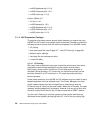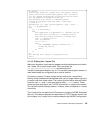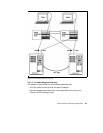56 IBM Certification Study Guide AIX HACMP
• nv6000.database.obj 4.1.0.0
• nv6000.Features.obj 4.1.2.0
• nv6000.client.obj 4.1.0.0
and for HAView 4.3
• xlC.rte 3.1.4.0
• nv6000.base.obj 4.1.2.0
• nv6000.database.obj 4.1.2.0
• nv6000.Features.obj 4.1.2.0
• nv6000.client.obj 4.1.2.0
3.1.4 AIX Parameter Settings
This section discusses several general tasks necessary to ensure that your
HACMP for AIX cluster environment works as planned. Consider or check the
following issues to ensure that AIX works as expected in an HACMP cluster.
• I/O pacing
• User and group IDs (see Chapter 2.7, “User ID Planning” on page 48)
• Network option settings
• /etc/hosts file and nameserver edits
• /.rhosts file edits
3.1.4.1 I/O Pacing
AIX users have occasionally seen poor interactive performance from some
applications when another application on the system is doing heavy
input/output. Under certain conditions, I/O can take several seconds to
complete. While the heavy I/O is occurring, an interactive process can be
severely affected if its I/O is blocked, or, if it needs resources held by a
blocked process.
Under these conditions, the HACMP for AIX software may be unable to send
keepalive packets from the affected node. The Cluster Managers on other
cluster nodes interpret the lack of keepalives as node failure, and the
I/O-bound node is “failed” by the other nodes. When the I/O finishes, the node
resumes sending keepalives. Its packets, however, are now out of sync with
the other nodes, which then kill the I/O-bound node with a RESET packet.
You can use I/O pacing to tune the system so that system resources are
distributed more equitably during high disk I/O. You do this by setting high-


















